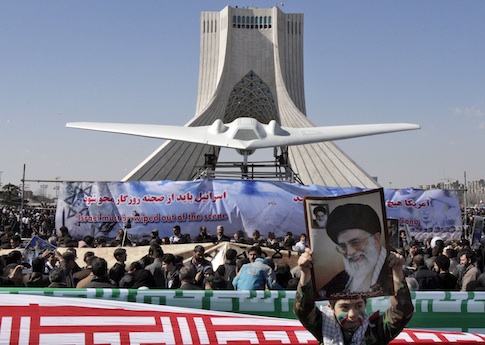The Iranian military says that it has fully reverse engineered a downed U.S. drone and armed it with missiles "to attack the U.S. warships in any possible battle."
The Iranian Revolutionary Guard Corps (IRGC) made the announcement on Sunday as Supreme Leader Ayatollah Khamenei toured an IRGC military compound to view the new drones, according to reports in Iran’s state-run media.
Iran also revealed over the weekend the existence of new ballistic missiles and an air defense system that can reportedly destroy multiple targets at once.
The unveiling of the new drone has been met with particular fanfare by the IRGC, which announced more than two years ago that it had successfully downed an RQ-170 drone built by Lockheed Martin.
Since capturing the U.S. surveillance plane, Iranian engineers have been working on decrypting the drone’s computers and reverse engineering a similar unmanned vehicle.
Iran claims to have now weaponized its own version of the RQ-170 "with bombing capability to attack the U.S. warships in any possible battle," according to the Fars News Agency.
An exhibition of the drone’s abilities took top billing during the IRGC exhibition attended by Khamenei, according to Fars.
"The highly-advanced radar-evading U.S. RQ-170 drone downed by the IRGC more than two years ago and its indigenized model developed by Iranian experts through reverse engineering were among the most important sections of the exhibition," Fars reported.
Iran claims to have been using intelligence gained after downing the U.S. drone to assemble a new line of homemade unmanned aerial vehicles (UAVs) that will be used to fight the United States.
While the U.S. version of the RQ-170 is used just for reconnaissance missions, "the IRGC Aerospace experts have equipped the Unmanned Aerial Vehicle (UAV) with bombing capabilities, enabling it to operate as a bomber aircraft against the U.S. warships in any possible showdown between the two countries," Fars reported.
The technology Iran gleaned from back-engineering the U.S. drone has set it about "35 years ahead" where it would have been otherwise, according to Brigadier General Amir Ali Hajizadeh, the commander of the IRGC’s Aerospace Force.
Additionally, the IRGC also displayed new ballistic missile technology reportedly capable of deploying multiple warheads at once.
The new ballistic missiles also were unveiled over the weekend during the IRGC’s military exhibition. Iran has referred to the missiles as "military hi-tech owned only by a handful of the world states."
The ballistic missile, named Zelzal, reportedly can carry " thirty 17-kg bombs" and "destroy a wide range of targets" such as airport runways and military installations, according to Fars.
Iran’s ongoing development of ballistic missiles has drawn concern in Washington, D.C., as they can be armed to carry a nuclear payload.
Iran’s ballistic missile program has continued under the interim nuclear deal, which does not cover such activities.
The Zelzal ballistic missiles were showcased alongside what the IRGC described as a new air defense system that can destroy four targets simultaneously from a range of about 30 miles.
"The Third of Khordad air defense system can trace and target fighter jets, bombers and cruise missiles up to 25,000 meters (almost 75,000) high," Fars reported. "All its components have been placed in a vehicle and its radar, tracing, and missile-launching systems have been improved."
